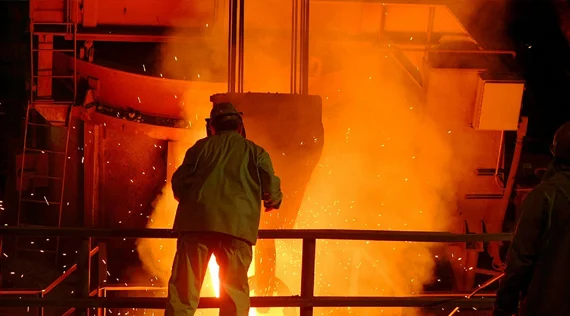AIIS Steel Market Update-Summer 2017
Steel News | 2017-07-17 07:57:14
The economy grew by 2.1 percent during the fourth quarter of 2016.BEA noted that “the general picture of economic growth remains the same.â€
Falls Church, VA (AIIS) - The economy did not start off 2017 quite as slowly as initially estimated.
The Bureau of Economic Analysis (BEA) in June revised its measure of growth in the first quarter to an annualized rate of 1.4 percent, up from the 0.7 percent that the agency announced in April and the 1.2 percent estimate of gross domestic product (GDP) growth in May. Despite the change, the BEA noted that “the general picture of economic growth remains the same.” The economy grew by 2.1 percent during the fourth quarter of 2016. “The deceleration in real GDP in the first quarter reflected a downturn in private inventory investment, a deceleration in [personal consumption expenditures], and a downturn in state and local government spending that were partly offset by an upturn in exports, an acceleration in nonresidential fixed investment, and a deceleration in imports,” the BEA stated. Consumer spending typically drives growth, accounting for about 70 percent of all economic activity, and consumers did not do much driving from January to March. Spending increased by just 1.1 percent during the first quarter, according to the BEA, the worst performance since Q2 of 2013, but much better than the 0.3 percent growth that the agency initially estimated. Analysts are expecting a better second quarter, with some forecasting growth of as much as 3 percent. If this is to happen, consumers will have to boost their spending. After shrinking by a non-annualized rate of 0.3 percent in January and being flat in February, consumer spending, according to the BEA, jumped 0.6 percent in March before growth slowed to 0.2 percent in April and 0.1 percent in May.
The Conference Board’s Consumer Confidence Index, which had stood at 124.9 in March fell to 117.6 in May before climbing to 118.9 in June. (The index’s baseline is 100 in 1985.) “Overall, consumers anticipate the economy will continue expanding in the months ahead, but they do not foresee the pace of growth accelerating,” the board’s director of economic indicators said.
The University of Michigan’s Index of Consumer Sentiment dipped from 97.1 in May to 95.1 in June, with researchers noting that, “Although consumer confidence slipped to its lowest level since Trump was elected, the overall level still remains quite favorable.” The index breaks down results by party affiliation, and it has regularly noted a stark “partisan divide” in consumer sentiment.
“Surprisingly, the optimism among Republicans and Independents has largely resisted declines in the past several months despite the decreased likelihood that Trump’s agenda will be passed in 2017,” researchers stated. “The most important policies to consumers are those that directly or indirectly affect their jobs, incomes, or their financial security. Fortunately, increasing uncertainty about future prospects for the economy has thus far been offset by the resurgent strength in the personal financial situation of consumers.”
In the manufacturing sector, confidence improved significantly from May to June, with the Institute for Supply Management’s Purchasing Managers Index increasing almost 3 points to 57.8 to reach its highest level in the past year. (An index over 50 indicates growth in the sector.) Of 18 industries surveyed, 15 reported growth.
“Comments from the panel generally reflect expanding business conditions; with new orders, production, employment, backlog and exports all growing in June compared to May and with supplier deliveries and inventories struggling to keep up with the production pace,” the chairman of the institute’s Manufacturing Business Survey Committee said.
Job growth in June came in above expectations, with 220,000 positions created, but the unemployment rate still inched up to 4.4 percent after reaching a 16-year-low of 4.3 percent in May. The labor force participation rate rose a tenth of a point to 62.8 percent in June. Ten years ago, the rate was around 66 percent, but it has dipped fairly steadily during the past decade because of both economic and structural factors – such as the retirement of baby boomers – and it has been mostly below 63 percent since late 2013.
As an analyst at Bankrate.com commented, “Once again, the buzz kill on the jobs report is the lack of more substantial wage growth.” The Federal Reserve Bank of Atlanta reported that wages increased at an annualized rate of 3.4 percent in May, better than the 2010-2013 period, when the monthly rate never surpassed 2.4 percent, but still well below pre-Great Recession levels.
Despite the economic indicators not being all positive, the Federal Reserve Federal Open Market Committee, at its June 13-14 meeting, increased the target range for the federal funds rate a quarter-point to 1 to 1.25 percent. This marked the second time this year – and the fourth time since the recession – that the Fed has raised rates.
“Information received since the Federal Open Market Committee met in May indicates that the labor market has continued to strengthen and that economic activity has been rising moderately so far this year,” the Fed stated in announcing the rate hike. “Job gains have moderated but have been solid, on average, since the beginning of the year, and the unemployment rate has declined. Household spending has picked up in recent months, and business fixed investment has continued to expand.”
Housing starts in May fell 5.5 percent from April and were 2.4 percent below the May 2016 level, according to the Census Bureau and the Department of Housing and Urban Development. Existing home sales, meanwhile, increased 1.1 percent from April to May after falling 2.3 percent the previous month.
“The job market in most of the country is healthy and the recent downward trend in mortgage rates continues to keep buyer interest at a robust level,” the association’s chief economist said.
Car sales have decreased sharply from last year, with June sales 13.2 percent below a year earlier and year-to-date sales down 11.4 percent compared to 2016, Motor Intelligence reported. Light-duty truck sales, however, were 4.2 percent higher in May than they were in May 2016, while year-to-date sales increased 4.6 percent.
The dollar remains strong, and it ended June trading at 0.88 euros, 0.77 pounds, 112.36 yen and 6.8 yuan.
The Dow Jones Industrial Average, which hovered around the 21,000 mark from March through May, after rising 15 percent from Election Day until then, reached 21,349.63 on June 30. The S&P 500 Index closed June at 2,423.41.
Trump on June 1 referred to the United States as having made “absolutely tremendous economic progress since Election Day. The economy is starting to come back, and very, very rapidly.” Even coming from a marketer known for using hyperbole, describing 1.4 percent growth as “very, very rapid” can only be met with incredulity. Trump was elected, at least in part, to bring a businessman’s touch to the White House and to push for pro-growth policies. Tax reform, for example, could, indeed, be “absolutely tremendous” for the economy, but Trump has been burning energy and, more importantly, political capital by creating or exacerbating controversies, and this lack of focus will only make an already difficult legislative challenge even tougher. The mandate he claimed in January withers away a little more with each ill-advised tweet. Further, as was evident during July’s G20 Summit in Germany, his preferred trade policies will alienate the nation’s trading partners to the point of making strong economic growth essentially impossible to achieve. The protectionism that Trump favors could only work if domestic substitutes were available at the same price and quality as imported goods and if other countries declined to implement retaliatory measures. Needless to say, neither of these conditions would be true. It is understandable that many Americans without a background in macroeconomics fail to see the long-term negative effects of moving the country away from free trade, but it is unacceptable for a president – particularly one who literally wrote the book on business – to be so economically naïve.
Courtesy: AIIS
 By
By 